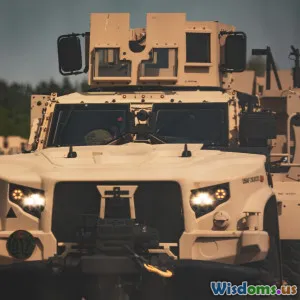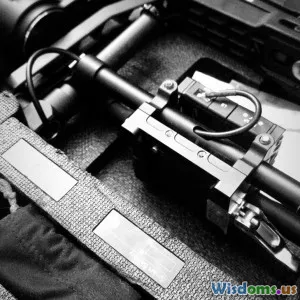
How Nations Track Illicit Arms Shipments Amid Global Tensions
9 min read Explore how nations track illicit arms shipments amid escalating global tensions using technology, intelligence sharing, and international law enforcement. (0 Reviews)
How Nations Track Illicit Arms Shipments Amid Global Tensions
In today’s turbulent geopolitical landscape, arms trafficking poses a daunting challenge that exacerbates conflict, undermines sovereignty, and fuels instability across regions. Amid mounting international tensions, many nations have sharpened their focus on tracking illicit arms shipments—an endeavor as complex as it is critical to global security. This article offers an in-depth exploration of the sophisticated methods, technologies, and collaborative frameworks countries use to detect and intercept illegal weapons moving across borders.
The Growing Threat of Illicit Arms Trafficking
According to the Small Arms Survey, an estimated 1 billion firearms are in circulation globally, with approximately 85% held by civilians, often acquired through illicit means. Illicit arms trafficking not only enables violent conflicts but also empowers criminal organizations, terrorist groups, and rogue states.
For example, the war-torn regions of the Sahel have become hotspots where small arms smuggled from Libya and other conflict zones fuel insurgency and extremism. Similarly, Eastern Europe has witnessed spikes in arms proliferation linked to unresolved regional disputes.
Understanding the multifaceted routes and networks that illicitly move weapons is key to developing effective tracking and interception strategies.
Tracking Methods Employed by Nations
1. Satellite Surveillance and Remote Sensing
Countries increasingly rely on satellites to monitor ports, border crossings, and known smuggling corridors. High-resolution optical and radar satellites can detect unusual movements of vehicles or cargo ships possibly carrying weapons.
For instance, the European Union’s Copernicus program provides open-source satellite imagery enabling member states to track suspicious shipments in the Mediterranean, a notorious channel for smuggling into Europe.
Moreover, Synthetic Aperture Radar (SAR) satellites pierce through cloud cover and darkness, enabling continuous surveillance vital for detecting camouflaged or hidden arms shipments.
2. Advanced Cargo Screening Technologies
Modern customs and border agencies employ sophisticated scanning technologies such as X-ray and gamma-ray imaging to detect concealed arms within shipping containers or vehicles.
The U.S. Department of Homeland Security’s Container Security Initiative has deployed such systems in major ports worldwide, reducing undetected illicit cargo by up to 60%, according to official reports.
Additionally, chemical trace detectors can sense residues of gunpowder or explosives on containers, indicating the presence of arms or related materials.
3. Intelligence Sharing and Multilateral Cooperation
No single nation can address illicit arms trade alone. Intelligence sharing platforms like INTERPOL’s Weapons and Explosives Crime Unit facilitate global communication on suspicious shipments, recovered weapons, and trafficking networks.
The United Nations Register of Conventional Arms, which promotes transparency about transfer activities, supports nations in monitoring and reporting on arms movements.
Importantly, regional partnerships such as the African Union’s Panel of the Wise have initiated joint monitoring mechanisms that synchronize efforts across borders to track and combat firearms trafficking.
4. Maritime Domain Awareness and Naval Patrols
Over 80% of global arms trafficking involves maritime routes. Countries deploy naval patrols, maritime surveillance drones, and Automatic Identification Systems (AIS) tracking commercial shipping to detect and intercept shipments over sea.
Operation Atalanta by the European Union Naval Force is an example where coordinated patrols deter arms smuggling to conflict zones in Somalia.
5. Blockchain and Data Analytics Cutting-Edge Tools
Emerging technologies such as blockchain are being piloted to create immutable digital supply chain records for arms exports. By securely tracing legitimate firearms from manufacture to authorized users, any diversion can be detected early.
Additionally, big data analytics synthesize intelligence from financial transactions, shipping manifests, and open-source information to identify suspicious patterns peculiar to illicit arms shipments.
Challenges in Tracking Illicit Arms
Despite technological advances, tracing illegal arms shipments remains beset by difficulties:
- False Documentation and Concealment: Traffickers use forged papers and sophisticated concealment techniques, such as hidden compartments or shipment blending, complicating detection.
- Jurisdictional Gaps: Differences in national laws and enforcement capabilities create loopholes that traffickers exploit.
- Limited Resources in Some Regions: Developing countries with porous borders often lack the capacity to deploy advanced monitoring tools or skilled personnel.
For example, the porous borders in Latin America enable narcotraffickers to smuggle arms from the U.S. into Central America, exacerbating gang violence and complicating enforcement.
Case Study: Tackling Arms Smuggling in Southeast Asia
Southeast Asia, with its archipelagic geography, constitutes a hotspot for illicit arms movement. Efforts by ASEAN nations to establish the ASEAN Regional Forum on Small Arms and Light Weapons have fostered intelligence sharing, joint naval patrols, and community awareness campaigns.
Success stories include the interception of illegal weapons shipments destined for insurgent groups in the southern Philippines, achieved through combined satellite data, human intelligence, and coordinated maritime responses.
Furthermore, international support from organizations like the UN Office for Disarmament Affairs has supplemented technical assistance and capacity building.
The Role of Policy and International Law
Arms Trade Treaty (ATT)
Enforced since 2014, the ATT regulates conventional arms transfers internationally to prevent diversion to illicit markets. Signatory nations commit to effective monitoring systems and reporting mechanisms.
Though non-universally adopted, the treaty has created normative pressure encouraging states to improve national export control regimes.
National Export Controls and Embargoes
Countries enforce strict licensing requirements and embargoes against prohibited entities. The U.S. International Traffic in Arms Regulations (ITAR) and the EU’s Common Position on arms exports exemplify regulatory frameworks aimed at curbing illicit trade.
Enforcement involves meticulous end-user verification and penalties for violations.
Civil Society and NGOs
Transparency advocacy groups like Amnesty International and the International Action Network on Small Arms (IANSA) monitor arms flows and pressure governments to uphold stringent tracking and controls.
They also assist with grassroots education initiatives that reduce demand for illicit weapons.
Conclusion: Enhancing Global Coordination to Stem Illicit Arms Flow
The clandestine nature of illicit arms trafficking coupled with geopolitical rivalries presents daunting obstacles. However, the convergence of cutting-edge technology, comprehensive intelligence-sharing networks, robust legal frameworks, and international cooperation is steadily improving nations’ ability to track and intercept illegal shipments.
Ultimately, a multilayered approach that blends surveillance, diplomacy, capacity building, and community engagement offers the best prospect for mitigating the profound human and security harms caused by illicit arms proliferation. As global tensions persist, continued innovation, transparency, and partnership remain essential to disrupting these shadowy supply chains and promoting lasting peace.
References
- Small Arms Survey 2023 Report
- United Nations Office for Disarmament Affairs
- INTERPOL Weapons and Explosives Crime Unit publications
- European Union Naval Force official statements
- Amnesty International reports on arms trafficking
Rate the Post
User Reviews
Other posts in International Arms Treaties and Regulations
Popular Posts















